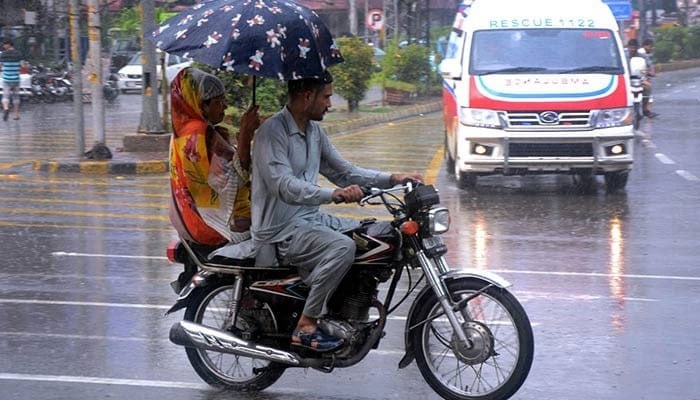Monsoon rains claim 111 lives in Pakistan since late June
PMD forecast very heavy to extremely heavy rainfalls in parts of KP, GB from July 14 to 17

More than 110 lives have been lost, including deaths of dozens of children, in monsoon rains across Pakistan since they hit different parts of the country in late June, according to government figures released on Monday.
Data from the National Disaster Management Authority (NDMA) between June 26 and July 14 showed that electrocution was the leading cause of fatalities, followed by flash floods.
In late June, at least 13 tourists were swept to their deaths while sheltering from flash floods on a raised river bank.
In its latest report, the disaster agency said 111 people including 53 children have been killed, with the highest number of deaths in the most populous province of Punjab.
The Pakistan Meteorological Department (PMD) has predicted heavy rains from July 15 to 17 as a low-pressure area (LPA) presently located over northwest Madhya Pradesh, India, is expected to affect Pakistan during the next 24 to 72 hours.
The PMD stated in a statement that under the influence of this weather system, strong monsoon currents are expected to penetrate the central and upper parts from July 15 to 17.
“A westerly wave is also present over the upper parts of the country,” it added. Due to these meteorological conditions:
The weather department forecast very heavy rainfalls coupled with rain-wind and thundershowers in parts of Kashmir, and isolated heavy falls in Gilgit-Baltistan from July 14 to 17, with occasional gaps.
It also predicted “very heavy to extremely heavy” rains in parts of Khyber Pakhtunkhwa from July 14 night to 17.
Azad Kashmir
Rain-wind/thundershower with scattered heavy falls (at times very heavy) is expected in Kashmir (Neelum valley, Muzaffarabad, Rawalakot, Poonch, Hattian, Bagh, Haveli, Sudhanoti, Kotli, Bhimber, Mirpur) from July 14 night to 17.
Gilgit-Baltistan
Rain-wind/thunderstorm (with isolated heavy falls) is expected in Gilgit-Baltistan (Diamir, Astore, Ghizer, Skardu, Hunza, Gilgit, Ghanche, Shigar) from July 14 (night) to July 17 with occasional gaps.
Khyber Pakhtunkhwa
Rain-wind and thundershower with scattered heavy falls (at times very heavy/extremely heavy) is expected in Dir, Chitral, Swat, Kohistan, Malakand, Shangla, Battagram, Buner, Kohat, Karak, Bannu, Tank, Lakki Marwat, Dera Ismail Khan, Bajaur, Mohmand, Khyber, Waziristan, Orakzai, Mansehra, Abbottabad, Haripur, Peshawar, Charsadda, Nowshera, Mardan, Swabi, Hangu and Kurram from July 14 (night) to 17 with occasional gaps.
Punjab/Islamabad
Rain-wind/thundershower with scattered heavy falls (at times very heavy/extremely heavy) is expected in Islamabad/Rawalpindi, Murree, Galliyat, Attock, Chakwal, Jhelum, Mandi Bahauddin, Gujrat, Gujranwala, Hafizabad, Wazirabad, Lahore, Sheikhupura, Sialkot, Narowal, Sahiwal, Jhang, Toba Tek Singh, Nankana Sahib, Chiniot, Faisalabad, Okara, Kasur, Khushab, Sargodha, Bhakkar, Mianwali, Bahawalpur, Bahawalnagar, D.G. Khan, Multan, Khanewal, Lohdran, Muzaffargarh, Rajanpur, Rahimyar Khan, Kot Addu and Layyah from July 14 (evening) to 17 with occasional gaps.
Balochistan
Rain-wind/thundershower with scattered heavy falls (at times very heavy) is expected in northeastern and southern parts (Quetta, Zhob, Qilla Saifullah, Qilla Abdullah, Ziarat, Sherani, Musakhel, Loralai, Sibbi, Bolan, Barkhan, Naseerabad, Kalat, Lasbella, Khuzdar, Awaran, Jaffarabad, Dera Bugti and Kohlu) from July 14 to 16.
Sindh
Rain-wind/thundershower is expected in Tharparkar, Mirpur Khas, Sanghar, Sukkur, Larkana, Dadu, Jacobabad, Khairpur and Shaheed Benazirabad from July 14 to 16 with occasional gaps. Light rain is also expected in Karachi.
Advising concerned authorities to remain on high alert, the PMD warned that the torrential rains may generate flash floods in local nullahs and streams, and hill torrents.
The downpours may also cause urban flooding in low-lying areas and road closures in vulnerable hilly areas due to landslides and mudslides.
Public, travellers and tourists have been advised to avoid unusual exposure in vulnerable areas to avoid any untoward situation and stay updated about weather conditions.
Monsoon season
Monsoon season brings South Asia 70 to 80% of its annual rainfall, arriving in early June in India and late June in Pakistan, and lasting through until September.
The annual rains are vital for agriculture and food security, and the livelihoods of millions of farmers.
But it brings with it flooding, landslides and causes buildings to collapse.
South Asia is getting hotter and in recent years has seen shifting weather patterns, but scientists are unclear on how exactly a warming planet is affecting the highly complex monsoon.
Pakistan is one of the world’s most vulnerable countries to the effects of climate change, and its 240 million residents are facing extreme weather events with increasing frequency.
In 2022, unprecedented monsoon floods submerged a third of Pakistan and killed 1,700 people, with some areas yet to recover from the damage.
In May, at least 32 people were killed in severe storms, including strong hailstorms.



